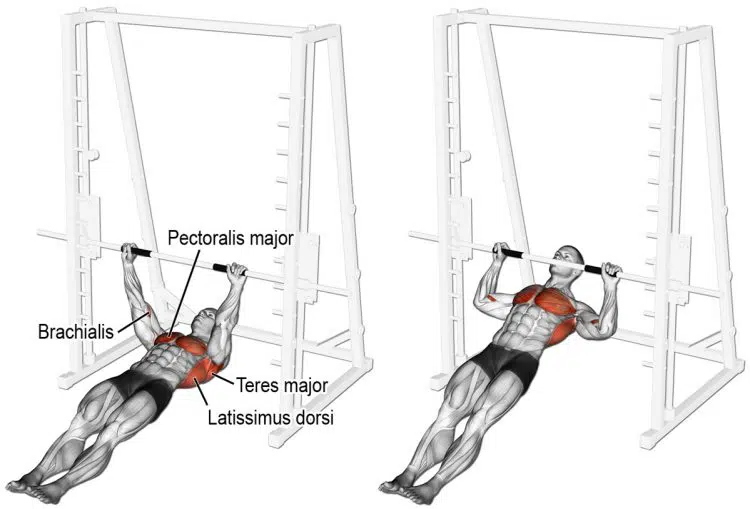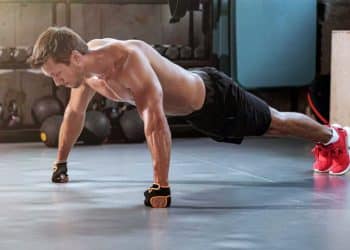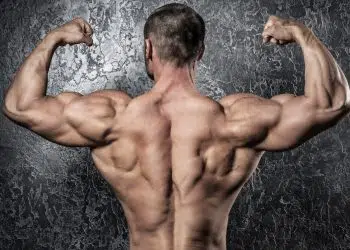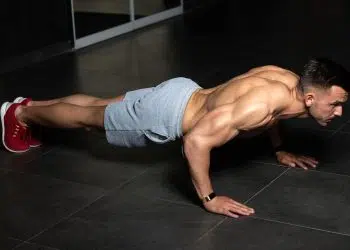Also known as the supine row or Australian pull-up, the inverted row is one of the most underrated yet effective back exercises.
It’s typically done using just bodyweight, however, there are several ways to advance this movement to make it harder and more effective. Not to mention it makes doing a form of bodyweight pull-ups possible for more people and it can be done in many different ways.
Learn all about this back exercise and how it can take your gains to the next level with this complete guide.
In this Exercise
- Target muscles Group: All back muscles (Latissimus Dorsi, Middle, and Lower Trapezii, Rhomboids, Teres Major, Teres Minor, Infraspinatus, Posterior Deltoid)
- Type: Strength
- Mechanics: Compound
- Difficulty: Intermediate
Muscles Worked
The inverted row works several muscles of the upper posterior chain (backside of the body). We’ve included brief details regarding the muscles worked during this excellent movement.
Infraspinatus
The infraspinatus muscle is a member of the rotator cuff family that forms the glenohumeral joint that functions to “assist in external rotation of the shoulder joint, scaption, and lateral rotation of the humerus”.
Level Up Your Fitness: Join our 💪 strong community in Fitness Volt Newsletter. Get daily inspiration, expert-backed workouts, nutrition tips, the latest in strength sports, and the support you need to reach your goals. Subscribe for free!
Along with several muscles, the infraspinatus stabilizes the shoulder and assists in various deltoid functions.
Latissimus Dorsi
The latissimus dorsi is a large back muscle that when developed appears as a set of wings. It runs from under the armpit area down to the lower back and contributes to thoracic and arm movements or motions.
While pull-ups may do the best job of maximizing activation of this back muscle, rows are really an excellent exercise for them as well.
Teres Major
The teres major is a thick muscle of the shoulder joint that medially rotates and adducts the arm and stabilizes the shoulder joint. Unlike the teres minor, it’s not a rotator cuff muscle.
Teres Minor
The teres minor is a rotator cuff muscle that, along with the other rotator cuff muscles functions to stabilize the glenohumeral joint. Its specific function is lateral, or external, rotation of the arm at the shoulder.
Trapezius Lower Fibers
The trapezius lower fibers are part of the trapezius muscle located on the upper back shaped liked a trapezoid. It depresses the scapula and aids the upper fibers in upward rotation of the scapula.
Most back exercises work the trap muscles that, when well developed, stick up on either side of the neck.
Trapezius Middle Fibers
The middle fibers of the trapezius muscle, between the upper and lower trap fibers, adduct (retract) the scapula.
Biceps
The biceps is a two-headed muscle located on the front of the upper arm. If you’ve ever been asked to flex your muscles, the biceps were probably what you showed off.
This muscle functions to supinate (palms up) and pronate (palms down) the forearm and plays a lesser role in elbow flexion. It also has a small function at the shoulder joint such as when you move your arm up and forward.
Any pulling movement activates the biceps muscle.
Brachialis
The brachialis is located just underneath the biceps toward the outside part of the upper arm. It’s a strong elbow flexor and is typically activated most when the hands are in a neutral position.
It gives width to the upper arm when developed.
Brachioradialis
A muscle located in the lateral forearm, the brachioradialis has a stronger role than the biceps during elbow flexion but when the forearm is pronated (palms down). It also helps to pronate and supinate the forearm, and therefore cross the elbow joint.
It can be a stubborn muscle but adds nice aesthetics to the forearms when well developed.
How To Do The Inverted Row
The inverted row is a simple movement however, for beginners especially, it can take a little adjusting and trial and error to find which position works best.
We’ve included step-by-step instructions to ensure you do it correctly for best results.
- Set the Smith machine bar high enough to where you can hold onto it with your arms extended when you’re positioned underneath it.
- Grip the bar using a slightly wider than a shoulder-width hand position.
- Straighten your legs so that your heels are on the ground and position yourself under the bar so that your nipples are somewhat in line with the bar. Stick your chest up, keep your shoulders back and tense your core to keep it rigid.
- Pull your body up to the bar to where your chest almost or does touch it by driving your elbows down toward the floor. Adjust in between if needed for a more comfortable position.
- Squeeze your shoulder blades and hold for 2 seconds at this position.
- Slowly extend your arms to return to the starting position while keeping the same body position.
- Repeat for the desired number of repetitions.
Inverted Row Tips
- Experiment a little to find the right bar height and body position for you.
- For the safety of your shoulders, do not position your elbows out wide but rather keep them at a 45-degree angle or less. Ideally, the bar should touch the nipples area or below.
- You can perform the movement with your legs on a bench as an easy technique to add more resistance using more of your body weight.
- Play with the position of the bar for best gains. The higher you set it the easier the movement while the lower the bar to the ground the harder it will be.
Check out this video example to see the inverted row in action
Best variations and Alternatives
As we mentioned before, there are many ways to do this exercise and that is suitable for all experience levels. Check them out.
Feet elevated
Aside from adjusting the bar height, the feet elevated variation is the simplest way to add more difficulty. Placing your feet in front of you on a bench or something similar shifts more weight toward the working muscles.
You may need to adjust the bench a few times to find a comfortable position.
Feet elevated + added weight
If the feet elevated only version is too easy for you try adding more weight. A few ways to do this is to wear a weighted vest or have someone place a weight plate on your lap.
Level Up Your Fitness: Join our 💪 strong community in Fitness Volt Newsletter. Get daily inspiration, expert-backed workouts, nutrition tips, the latest in strength sports, and the support you need to reach your goals. Subscribe for free!
Use any other bar or setup
While it’s very convenient, you don’t need a Smith machine to do inverted rows. A strong table, piece of exercise machinery, park rails, TRX (or alternatives), or anything suitable you can find will do just the same.
You could also use rings if you like seeing as you think you could PULL it off… pun intended of course.
Read: How To Do Inverted Rows At Home – Strong Back and Bigger Biceps
Rows
As an alternative to the inverted row, if maybe you’re not capable or you don’t have access to anything to do them on, rows make an excellent option to train essentially the same muscles.
Anything from bent-over row variations to standing rows, resistance band rows, TRX rows, etc are fantastic options.
How To Include The Inverted Row In Your Training
The inverted row can be incorporated alongside your other back exercises. But because it’s a great option for when you do not have much access to training equipment, it can serve as your only back movement for the majority of your training.
Although, we do recommend doing more than one exercise per muscle group. However, sometimes options are limited.
Need some awesome back workouts? Check out our database of training guides.
It’s a good replacement for row and pull-up variations but also makes for a good warm-up movement or finisher when you just want to rep out using your own body weight.
Use your own body weight or add more resistance depending on your level of training experience.
Benefits
The inverted row is a very beneficial exercise.
Bigger and stronger back muscles
This one is quite obvious but with enough resistance, the inverted row can put size on your back and level up your strength.
Eventually, it will become too easy and the lack of challenge can stall gains. Use the variations to continue making progress with this movement.
Almost anyone can do them
The fact of the matter is most people cannot do a pull-up. Well, aside from pull-down variations the inverted row is the next best option. It takes a lot of strength to move full body weight but this exercise, when done in its basic form, removes a percentage of weight by shifting it away from the working muscles.
Can be done in many different ways
Again, you can use whatever you can find that’s sturdy enough to support your weight and give you enough room to perform the exercise.
Feel free to get creative too. Even using a sheet closed in a door could work but be extra careful and we recommend something with cushion on the floor.
Stall bars are also a great option for row variations.
Little to no setup
The inverted row takes no time at all to get set up and going. That means it’s also great for supersets.
Drawbacks
With the positives also comes potential negatives too.
Harder to get used too
Unlike just picking up some dumbbells to do rows or pulling yourself up to a bar with pull-ups, performing the inverted row can be a little uncomfortable especially at first and if you’re not used to doing them.
That’s because you’re locked in and also have to figure out what to do with your lower body too (unlike with a pull-up).
With experience and a little adjusting though, you’ll like this movement.
Starting position
Another con to the inverted row is that you have to get down on the floor to do them. While it’s not really a big deal, some may not be comfortable with it.
May not be the best way to make progress
After using the bodyweight variations, increasing the resistance may not always be possible. Wearing a weighted vest or adding a weight plate on your lap isn’t always an option or appealing either.
The Inverted Row Is A Very Versatile Exercise
From being a good option for beginners to offering advanced variations, the inverted row gets a big thumbs up from us for its versatility. Don’t have a Smith machine? No problem. Use a variety of things to get your sets in and there are no excuses.
Interested in measuring your progress? Check out our strength standards for Pull Ups, Inverted Row, Bent Over Row.












